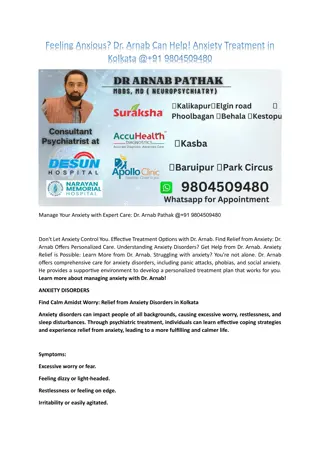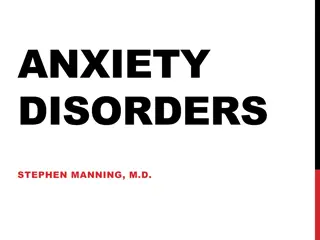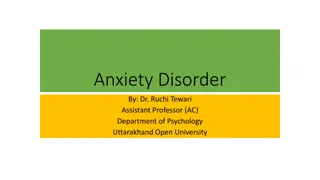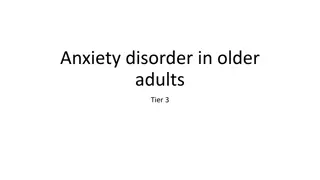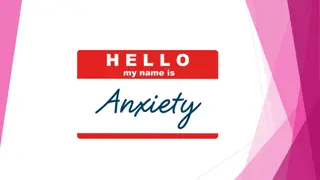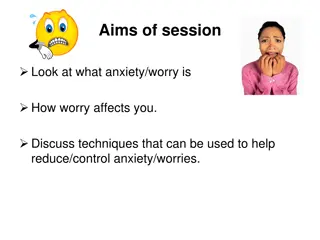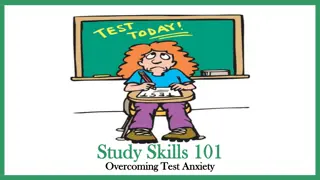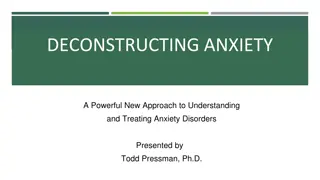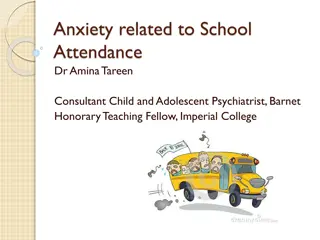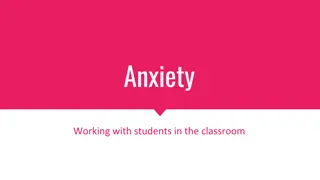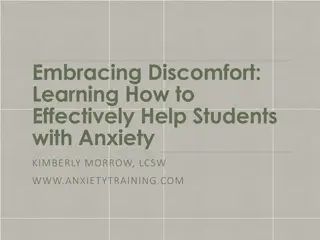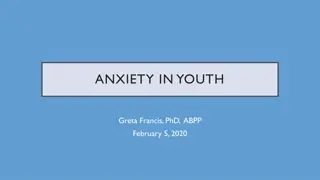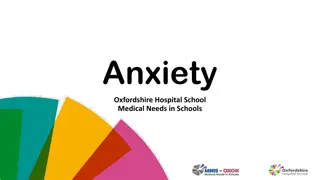Understanding Anxiety Disorders: A Comprehensive Guide
Anxiety disorders are common mental health issues characterized by fear, anticipation of future threats, and avoidance behaviors. This overview covers the differences between stress and anxiety, types of anxiety disorders according to DSM-5, prevalence rates, impact on individuals, and the specific details of Generalized Anxiety Disorder. Effective interventions are essential for managing anxiety and improving quality of life.
Download Presentation

Please find below an Image/Link to download the presentation.
The content on the website is provided AS IS for your information and personal use only. It may not be sold, licensed, or shared on other websites without obtaining consent from the author. Download presentation by click this link. If you encounter any issues during the download, it is possible that the publisher has removed the file from their server.
E N D
Presentation Transcript
Managing Stress / Anxiety www.ChangeThatMatters.umn.edu
Stress vs Anxiety Everyone experiences stress! Can be useful to motivate. Can be debilitating when overwhelming Stress is generally a response to a THREAT Is temporary Anxiety is the REACTION to the stress Mental health issue Many interventions are helpful with both stress and anxiety
Some anxiety is normal
What are anxiety disorders? Anxiety disorders are a combination of fear (emotional response to real/perceived threat) and anxiety (anticipation of FUTURE threat). People may engage in a lot of efforts to AVOID to minimize anxiety doing so perpetuates the anxiety
DSM5 Organization: Anxiety Disorders (lifetime prevalence from international research) Specific phobia (7%) Generalized anxiety disorder (GAD) (4-5%) Social anxiety disorder (4%) Panic disorder (1.7%) Lifetime prevalence of a panic attack is 13% Agoraphobia (1.5%) Separation anxiety disorder (childhood) Selective mutism (childhood)
Prevalence Anxiety disorders are actually MORE prevalent than depression Prevalence in the US of all anxiety disorders Lifetime prevalence: ~30% 12-month prevalence: 10%
Anxiety disorders Onset: Many start in childhood & persist Gender: Most occur more often in women than men (overall 2:1 ratio) Need to cause distress or impairment in social, occupational, or other important areas of functioning
Anxiety can be impactful Consequences of anxiety disorders Lower quality of life Decreased productivity Increased rates of medical service use Disability caused by GAD is considered equal to that of Major Depressive Disorder
Generalized Anxiety Disorder Lifetime prevalence: 4-5% Lifetime comorbidity: 82% Mood disorder comorbidity: 63% Other anxiety disorders: 52% Treatment is sought by about 50% of people with GAD (more in higher income countries)
Why Important in Primary Care? Anxiety disorders are: Common Highly comorbid with medical problems Very commonly missed or misdiagnosed by PCPs Research shows rates of misdiagnosis as high as 70% for GAD 86% for panic disorder 98% for social anxiety disorder
Why Often Missed in Primary Care? 70-90% of patients with anxiety present with somatic complaints What do you hear? Headaches, GI distress, muscle tension, chest pain, heart palpitations Patient lack of insight/resistance to idea of anxiety Are you saying I m CRAZY, Doctor?
Why Often Missed in Primary Care? Challenge of comorbidity Over 90% of patients w/ GAD have a comorbid psychiatric diagnosis (about have Major Depressive Disorder) Anxious patients with comorbid mental health disorders have lower remission rates and higher rates of suicide Commonly comorbid medical issues Chronic pain, headaches, IBS, sleep problems
Assessment Need to rule out other causes Metabolic panel, thyroid, cortisol levels to rule out electrolyte abnormalities, hyperthyroidism, Cushing syndrome Other medications, illicit substances, vitamins, herbs Caffeine, alcohol, nicotine
Assessment Tools No concrete data suggesting benefit to routine screening GAD7 Scoring: 5 (mild), 10 (moderate), 15 (severe) GAD2 86% sensitive, 83% specific for GAD
Formal Assessment of Generalized Anxiety Disorder Generalized Anxiety Disorder - 7
Comorbidity with Depression Given the huge overlap between depression & anxiety, if you see one, assess for the other!
FDA Approved Medications (as of November 2019) GAD Lexapro, Paxil, Effexor, Cymbalta Panic Prozac, Paxil, Zoloft, Effexor, Klonopin, Xanex Social anxiety disorder Paxil, Zoloft, Effexor XR
Only Grade A recommendation for anxiety Psychotherapy can be as effective as medications for GAD & Panic Disorder. Cognitive behavioral therapy has the best level of evidence.
Grade B recommendations Physical activity is a cost-effective treatment for GAD & Panic Disorder SSRIs are a first-line therapy for GAD and Panic Disorder
Grade B recommendations Benzodiazepines (BZ) do not improve long-term outcomes. Should be used only short-term during crises (due to risk for tolerance/dependence) BZs are to anxiety what Opioids are to pain Highly effective in the short term Abused by some Discouraged but sometimes indispensable for chronic use Avoid in patients with a history of addiction
Model by Murray Stein & Michelle Craske JAMA, 2017 JAMA 2017
Model by Murray Stein & Michelle Craske Often stepped care may start with exercise & stress management (e.g., via apps) If SSRI or SNRI, start at lowest available dose & titrate up every 2-4 weeks to minimize adverse effects If antidepressant helps, continue for 9-12 months before stopping/tapering
Change That Matters Focus on Values and Meaning in Life
Anxiety and Meaning When people feel stressed or anxious, they often withdraw from meaningful activities A powerful intervention is to reconnect to a source of meaning and engage in activities that are meaningful, such as: Relationships Work or volunteering Education or training (growth) Citizenship or community life
You only have 24 hours a day How do you want to spend those hours? Questions to ask: What really matters to me? What makes my life meaningful? How can I help someone else? How can I use my skills/talents to make a difference
Two Tools for Addressing Stress / Anxiety in Primary Care Catch/Challenge/Change Controllable vs Uncontrollable Stressors
What tips do you give patients who are dealing with anxiety? Ask for help Exercise Mobile apps Pray / meditate
Catch, Challenge, Change CATCH CHALLENGE CHANGE
Challenge: What is under my control?
Role of Physician Explore cycle of anxiety/stress and somatic complaints Anxiety Increased muscle tension, tightening, cramping Physiological Arousal
Role of Physician Encourage selection of a goal Exercise, relaxation, deep breathing, phone app Acknowledge some relationship/family situations can be stressful. Set limits with some people? Explore who can help with stress/anxiety Personal life Psychotherapy Spiritual leaders
Noteworthy Features of the Handout Education regarding stress Identification of personal experience of stress/anxiety Reflection on controllable versus uncontrollable stressors Tips on how to deal with different stressors Goal setting Elicitation of social support Specific tips (e.g., physical activity, distraction, therapy, mobile apps)
Documentation Template Current major life stressors *** How patient experiences stress (e.g., body, thoughts, behavior): *** Current treatments: (medication, therapy, exercise, self-help, social support, other ***) Support person who can help manage stress effectively: *** Plan: Specific goal (patient will try this to manage stress): *** Referrals: (Behavioral health, outside MH facility, psychiatry, Intensive Outpatient, other ***) Follow-up: *** Change that Matters Managing Stress handout given. *** minutes spent counseling patient on managing stress/anxiety to improve health
After Visit Summary (AVS) Template Today we talked about ways to manage stress. You set a goal to *** We will follow up on this plan at your next appointment. Here are some other ideas to help manage stress: Get active! Spend time reflecting, praying, or meditating. Ask yourself a simple 4-word question: IS IT WORTH IT? If the stressor is really important, use healthy coping tools. If not, can you let it go? How freeing might that feel? Distract yourself. Ask someone you trust for support. Consider therapy. Use relaxation and deep breathing strategies to calm your mind and body.
Practice Activity Partner with someone near you! Patient: a resident, Frank, who is way behind on notes, feels the faculty are hypercritical, is worried about getting kicked out of residency, and worries his wife may leave as he s never home Other person is the provider You determine diagnosis of generalized anxiety disorder. Using the pamphlet and EHR template, work through the intervention Take about 5 minutes; reverse roles.
But Doc Are you saying this is all in my head? I m not crazy! Legitimize suffering it s REAL Acknowledge: Sometimes the precise etiology of somatic symptoms is unknown. May be both We DO know that there s a vicious cycle and managing stress well can help in coping with somatic symptoms
But Doc I m just TOO anxious to try any of these things! Acknowledge that the anxiety is real. Explore: Is what you re doing working now? Reassure patient he/she is in control; can make small steps whenever ready.
But Doc.. I ve avoided (behavior) for so long. It s going to be really hard to try again Acknowledge avoidance as understandable. Help patient balance short-term benefits of avoidance with long-term negative consequences Remind patient WHY he/she wants to do this (tie to his/her values) Encourage patient to ACT even if he/she doesn t feel like it Set specific goal
Locke, Kirst, & Shultz. (2015). Diagnosis and management of generalized anxiety disorder and panic disorder in adults. American Family Physician, 91(9) 617-624 Stein, M., & Craske, M. (2017). Treating anxiety in 2017: Optimizing care to improve outcomes. JAMA, 318(3), 235-236



